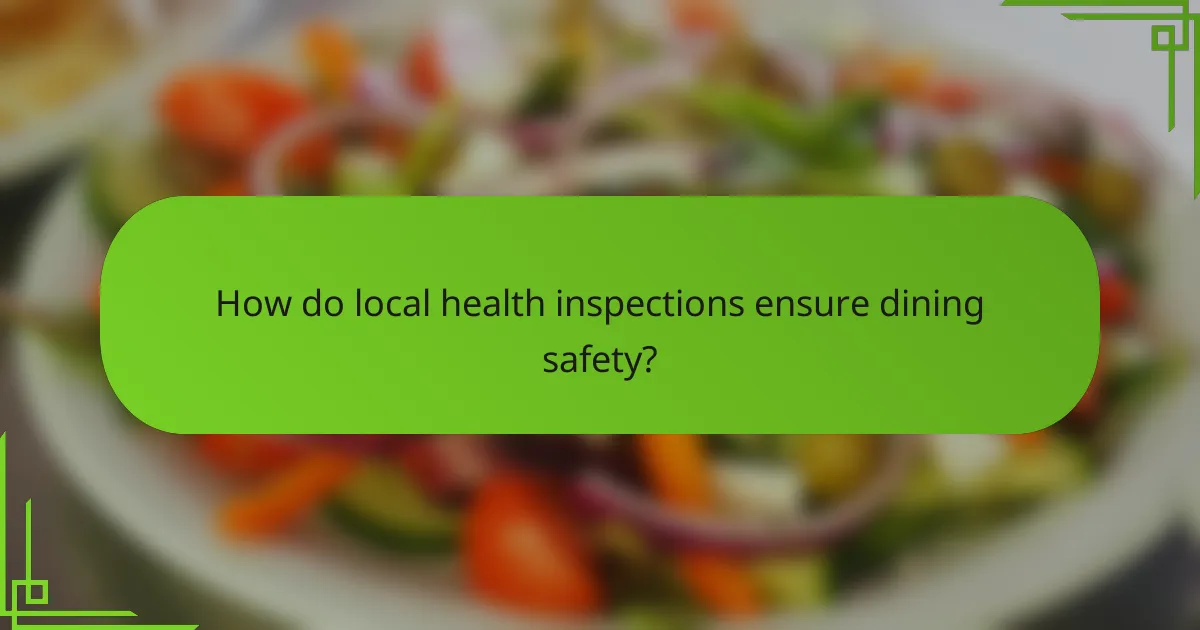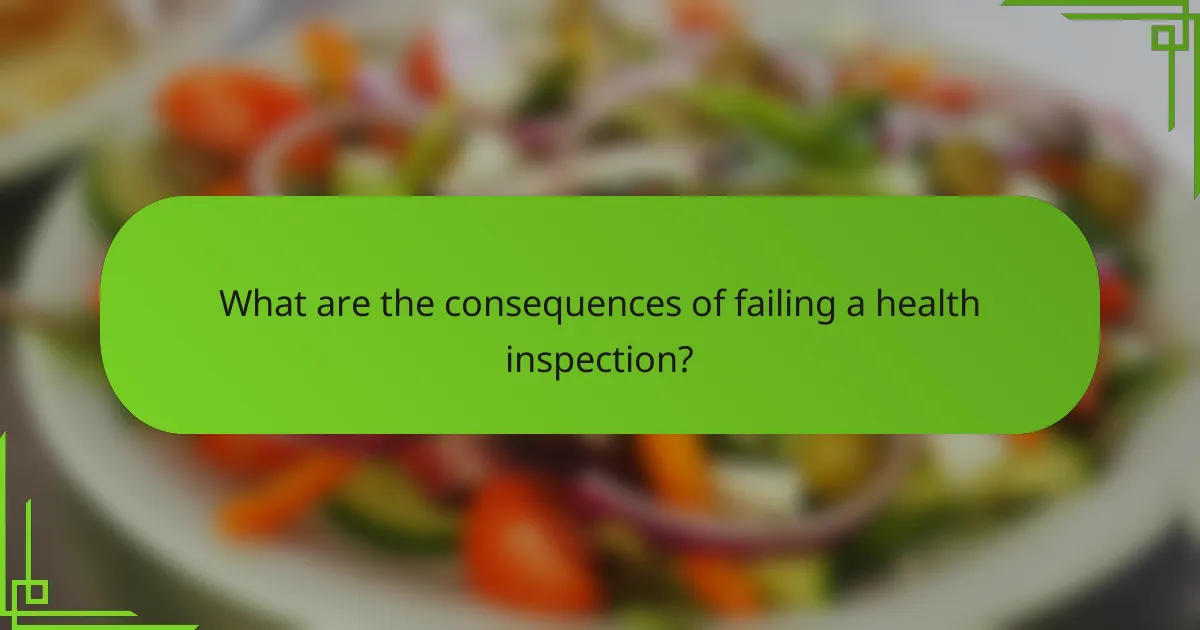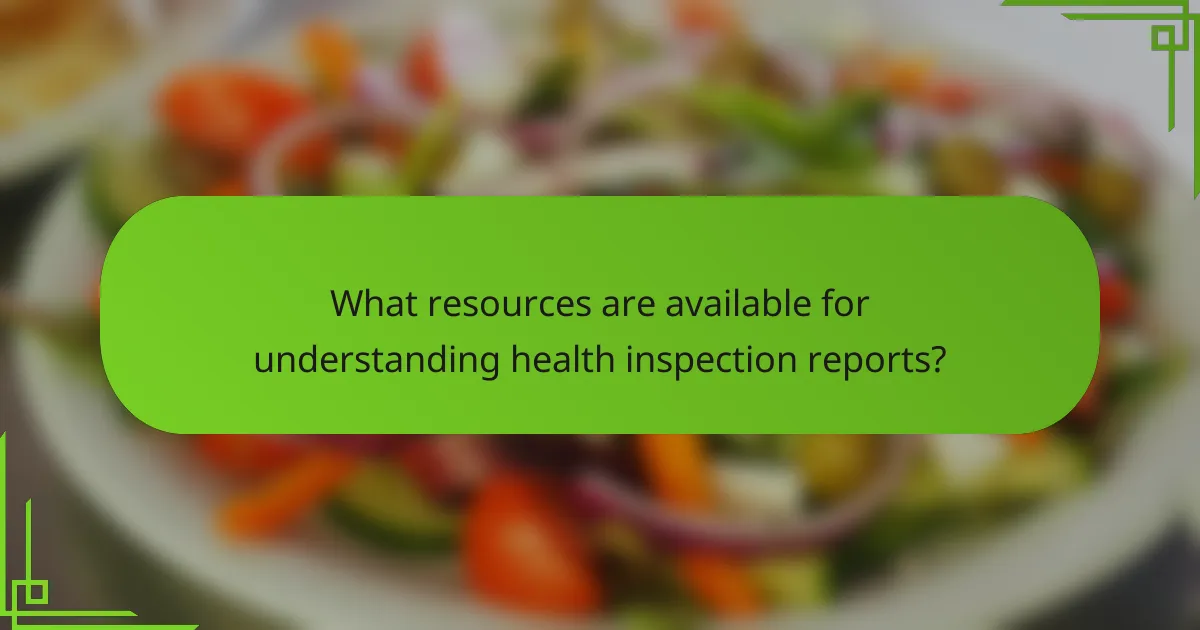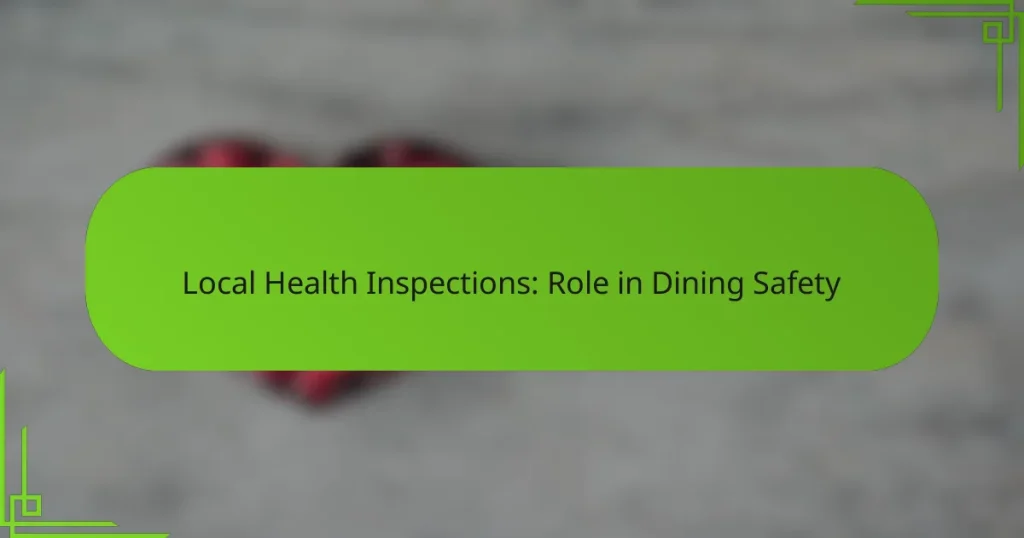Local health inspections are essential for maintaining dining safety by assessing restaurants and food establishments against health regulations. These evaluations help identify potential hazards and enforce necessary food safety practices, ultimately protecting public health from foodborne illnesses.

How do local health inspections ensure dining safety?
Local health inspections play a crucial role in ensuring dining safety by evaluating restaurants and food establishments for compliance with health regulations. These inspections help identify potential hazards and enforce food safety practices to protect public health.
Regular inspections by health departments
Health departments conduct regular inspections of dining establishments to assess their adherence to food safety regulations. These inspections typically occur at least once or twice a year, but the frequency can vary based on the type of establishment and its compliance history.
During these inspections, health inspectors evaluate various factors, including food storage temperatures, cleanliness, and employee hygiene practices. Establishments that consistently meet health standards may qualify for less frequent inspections.
Enforcement of food safety standards
Enforcement of food safety standards is a key function of local health inspections. Inspectors check for compliance with established guidelines, which may include proper food handling, sanitation practices, and equipment maintenance.
When violations are found, inspectors can issue citations, require corrective actions, or even temporarily close establishments until issues are resolved. This enforcement helps ensure that restaurants maintain a safe environment for customers.
Public reporting of inspection results
Public reporting of inspection results enhances transparency and accountability in the dining industry. Many health departments provide online access to inspection reports, allowing consumers to view the safety ratings of local restaurants.
This information empowers diners to make informed choices about where to eat. Establishments with poor inspection results may face reputational damage, motivating them to improve their food safety practices.

What are the key components of a health inspection?
Health inspections focus on several critical components that ensure food safety in dining establishments. These components include food handling practices, sanitation and cleanliness, and employee health and hygiene, all of which play a vital role in preventing foodborne illnesses.
Food handling practices
Food handling practices are essential for maintaining safety in food preparation and service. Inspectors evaluate how food is stored, cooked, and served, ensuring that temperatures are within safe ranges to prevent bacterial growth. For example, hot foods should be kept above 140°F (60°C), while cold foods must remain below 40°F (4°C).
Common pitfalls include cross-contamination, where raw foods contaminate cooked items. Establishments should use separate cutting boards for meats and vegetables, and staff should be trained on proper food handling techniques to minimize risks.
Sanitation and cleanliness
Sanitation and cleanliness are critical in preventing contamination in food service environments. Inspectors check surfaces, utensils, and equipment for cleanliness, ensuring that they are free from food residues and harmful pathogens. Regular cleaning schedules should be established, with a focus on high-touch areas like countertops and door handles.
Establishments should use approved sanitizers and follow manufacturer guidelines for dilution and contact time. A simple checklist can help staff maintain cleanliness: clean as you go, sanitize surfaces after use, and conduct deep cleans regularly.
Employee health and hygiene
Employee health and hygiene are pivotal in safeguarding food safety. Inspectors assess whether staff follow proper hygiene practices, such as handwashing and wearing clean uniforms. Employees should wash their hands frequently, especially after handling raw foods or using the restroom.
Establishments should implement policies that require sick employees to stay home, reducing the risk of foodborne illnesses. Training programs on hygiene practices can further enhance employee awareness and compliance, ensuring a safer dining experience for customers.

How often are health inspections conducted in restaurants?
Health inspections in restaurants are typically conducted on a regular basis to ensure compliance with food safety standards. The frequency of these inspections can vary significantly depending on local regulations and the specific jurisdiction in which the restaurant operates.
Frequency varies by jurisdiction
The frequency of health inspections is determined by local health departments and can differ widely from one area to another. Some jurisdictions may conduct inspections multiple times a year, while others may have less frequent schedules. Factors influencing this variability include the size of the restaurant, its history of compliance, and local health policies.
For instance, urban areas with a higher density of dining establishments may have stricter inspection schedules compared to rural regions. It is essential for restaurant owners to be aware of their local regulations to ensure they remain compliant.
Typical schedules range from quarterly to annually
Most restaurants can expect health inspections to occur anywhere from quarterly to annually. Establishments that have had previous violations or complaints may face more frequent inspections as a corrective measure. Conversely, restaurants with a clean record may qualify for less frequent checks.
For example, a restaurant in a metropolitan area might be inspected every three to six months, while one in a smaller town may only see an inspector once a year. Understanding these schedules helps restaurant owners prepare adequately and maintain high food safety standards.

What are the consequences of failing a health inspection?
Failing a health inspection can lead to serious repercussions for a dining establishment, including financial penalties and operational disruptions. These consequences are designed to ensure compliance with health standards and protect public safety.
Fines and penalties
Restaurants that fail health inspections often face fines that can range from hundreds to thousands of dollars, depending on the severity of the violations. These financial penalties serve as a deterrent against neglecting health regulations.
In some jurisdictions, repeated failures can lead to increased fines or even legal action. Establishments should be aware of their local health department’s fee structure to better prepare for potential costs associated with non-compliance.
Temporary closure of the establishment
A significant consequence of failing a health inspection is the potential for temporary closure. If violations are deemed critical, health inspectors may order an immediate shutdown until issues are resolved. This can disrupt business operations and lead to loss of revenue.
To avoid such closures, restaurants should conduct regular self-inspections and address any health code violations proactively. Maintaining high standards can help ensure compliance and minimize the risk of enforcement actions.

How can restaurants prepare for health inspections?
Restaurants can prepare for health inspections by implementing proactive measures that ensure compliance with food safety regulations. This includes regular staff training, conducting self-inspections, and maintaining a clean and organized environment.
Regular staff training on food safety
Regular staff training on food safety is essential for ensuring that all employees understand proper food handling techniques. Training should cover topics such as personal hygiene, cross-contamination prevention, and safe cooking temperatures.
Consider scheduling training sessions at least quarterly, supplemented by refresher courses during staff meetings. Utilizing visual aids and hands-on demonstrations can enhance understanding and retention of food safety practices.
Conducting self-inspections
Conducting self-inspections allows restaurants to identify and address potential health code violations before official inspections occur. Establish a checklist based on local health regulations to guide these inspections, focusing on critical areas like food storage, equipment sanitation, and employee practices.
Perform self-inspections monthly and document findings to track improvements over time. This proactive approach not only prepares staff for formal inspections but also fosters a culture of accountability and safety within the restaurant.
Maintaining cleanliness and organization
Maintaining cleanliness and organization is crucial for passing health inspections and ensuring food safety. Regularly clean and sanitize all surfaces, equipment, and utensils, and establish a daily cleaning schedule for staff to follow.
Organize storage areas to ensure that food items are properly labeled and stored at appropriate temperatures. Implementing a first-in, first-out (FIFO) system for inventory management can help minimize waste and ensure freshness.

What resources are available for understanding health inspection reports?
Health inspection reports can be understood through various resources, including local health department websites, online databases, and educational materials. These resources provide insights into inspection results, grading systems, and the implications for dining safety.
Local health department websites
Local health department websites are primary sources for accessing health inspection reports. They often publish inspection results, including scores and violation details for restaurants and food establishments in the area. Users can typically search by restaurant name or location to find specific reports.
Many health departments also provide educational resources that explain how inspections are conducted and what the scores mean. Familiarizing yourself with these resources can enhance your understanding of the dining safety landscape in your community.
Online databases and apps
Online databases and mobile applications aggregate health inspection data from various jurisdictions, making it easier for consumers to access and compare restaurant safety records. These platforms often feature user-friendly interfaces that allow for quick searches and filtering based on location, cuisine, or inspection scores.
Some popular apps even include user reviews and photos, providing a more comprehensive view of dining establishments. However, it’s essential to verify that the data is up-to-date and sourced from reliable local health authorities.
Educational materials and guides
Educational materials, such as guides and articles, can help you interpret health inspection reports effectively. These resources often break down common violations, grading systems, and the significance of different scores. Understanding these elements can empower diners to make informed choices about where to eat.
Look for materials from reputable organizations or health departments that focus on food safety. They may also offer tips on what to look for in a report and how to assess the overall safety of a dining establishment.


